Science & Data Document Library
Science and Data Resources
Edwards Aquifer Authority Data Management Plan

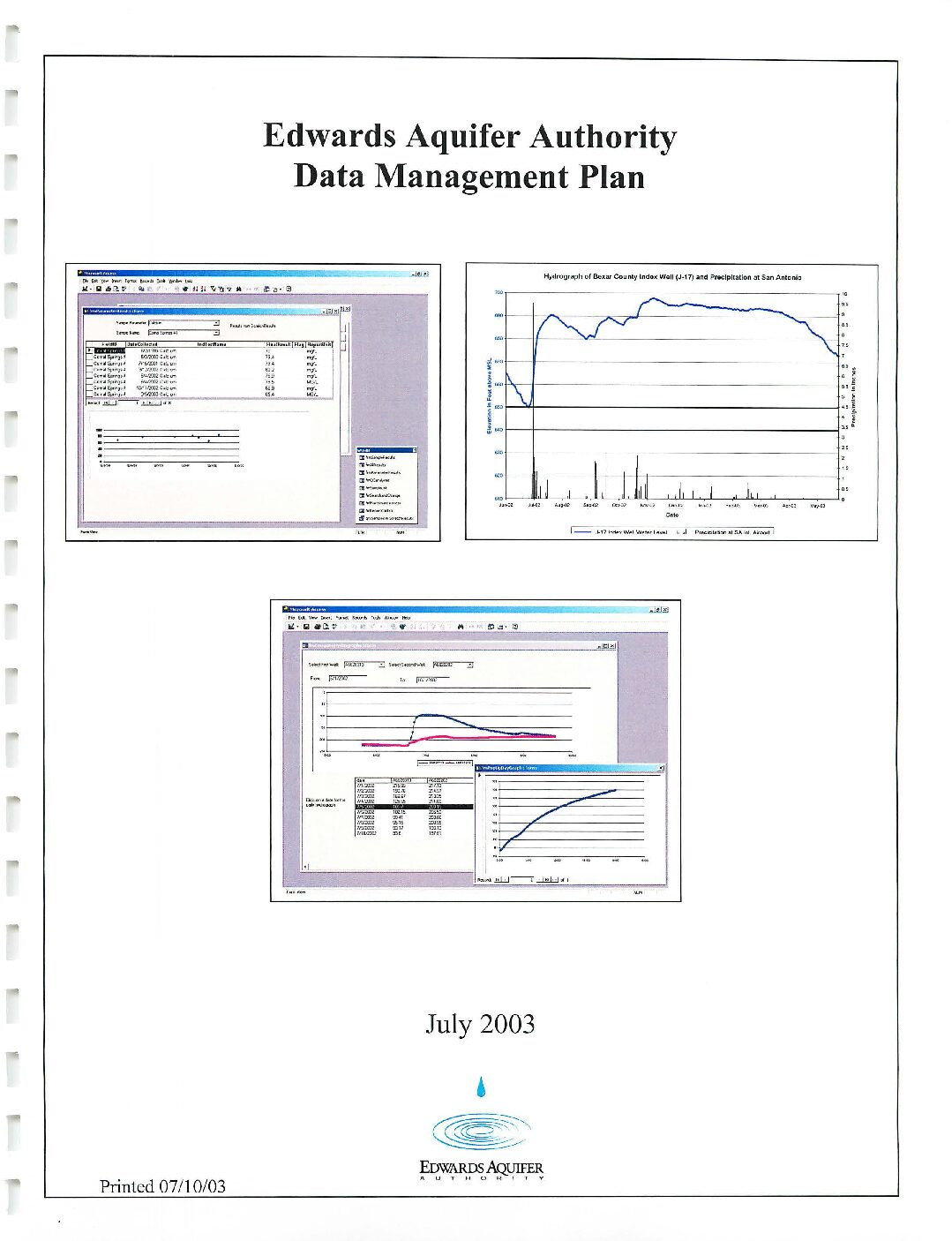
Description: Description the objective, tasks, and database structure for the Edwards Aquifer Authoritys data management system
Location: Edwards Aquifer, Balcones Fault Zone, San Antonio Segment
Summary:The Edwards Aquifer Authority (Authority), its predecessor agency (the Edwards Underground Water District; EUWD), and their contractors maintain an extensive data collection program that generates a large volume of data. The program has generated data such as water levels, water quality analyses, elevation survey measurements, rainfall measurements, and other information related to the Edwards Aquifer. Early data were stored in paper files and reports, and subsequent data were stored in spreadsheets. Currently, there is no single repository for data collected by the Authority. This plan was written to design and implement a data management system that will be used by the Authority in the future. It includes historical as well as current data. The scope of the system includes both hard copy files and computerized data storage and retrieval. The system fulfills one of the requirements of the Strategic Plan 2002-2006 that was adopted by the Authority in 2002. In addition, it will reflect requirements generated by the Data Management team.
This plan describes the objective, tasks, and database structure for the data management system.
Edwards Aquifer System [Map]

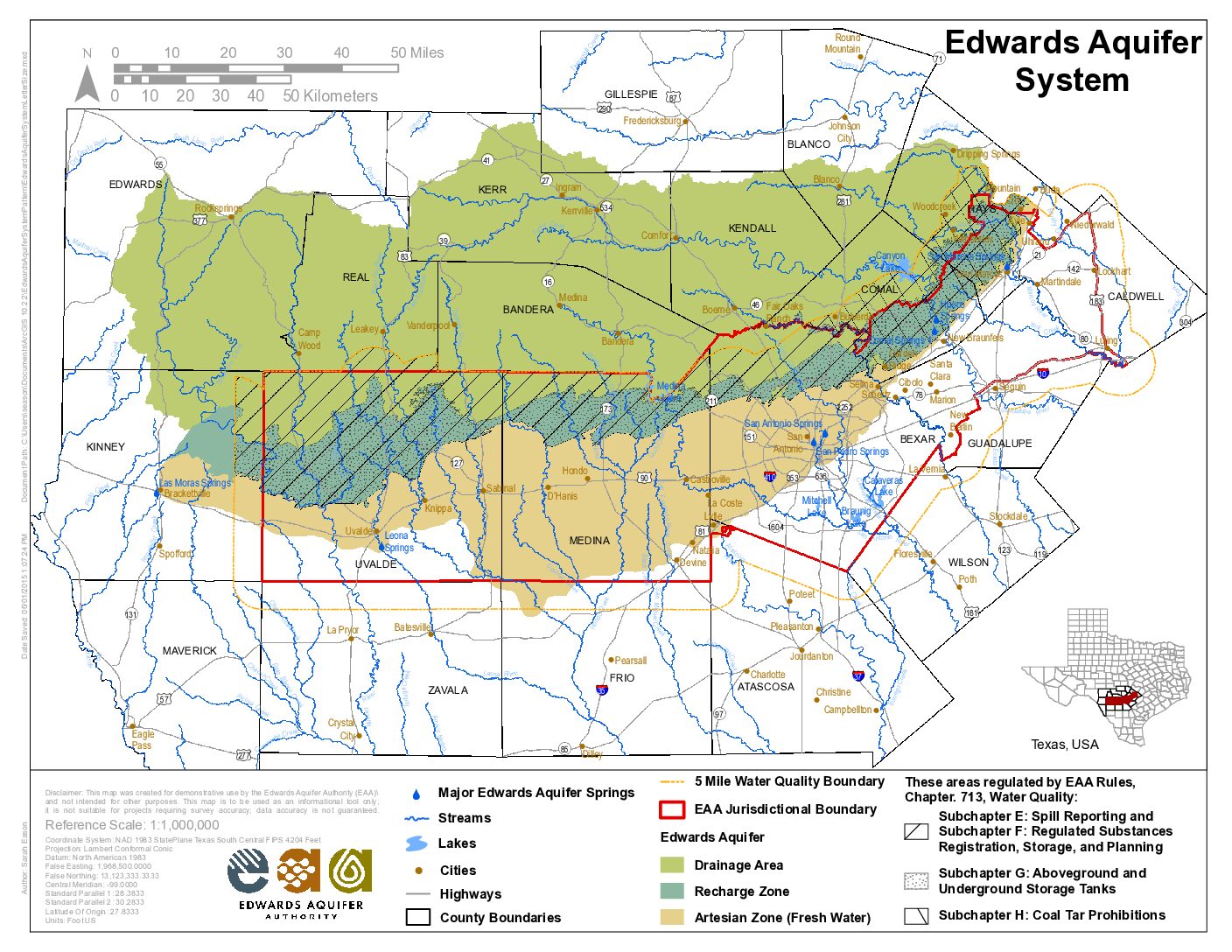
Description: Map of the Edwards Aquifer System, Balcones Fault Zone, San Antonio Segment
Location: Edwards Aquifer, Balcones Fault Zone, San Antonio Segment
Summary:Map showing features and political boundaries of the Edwards Aquifer System, Balcones Fault Zone, San Antonio Segment
Fifth Biennial Report on the Effectiveness of the Edwards Aquifer Authority

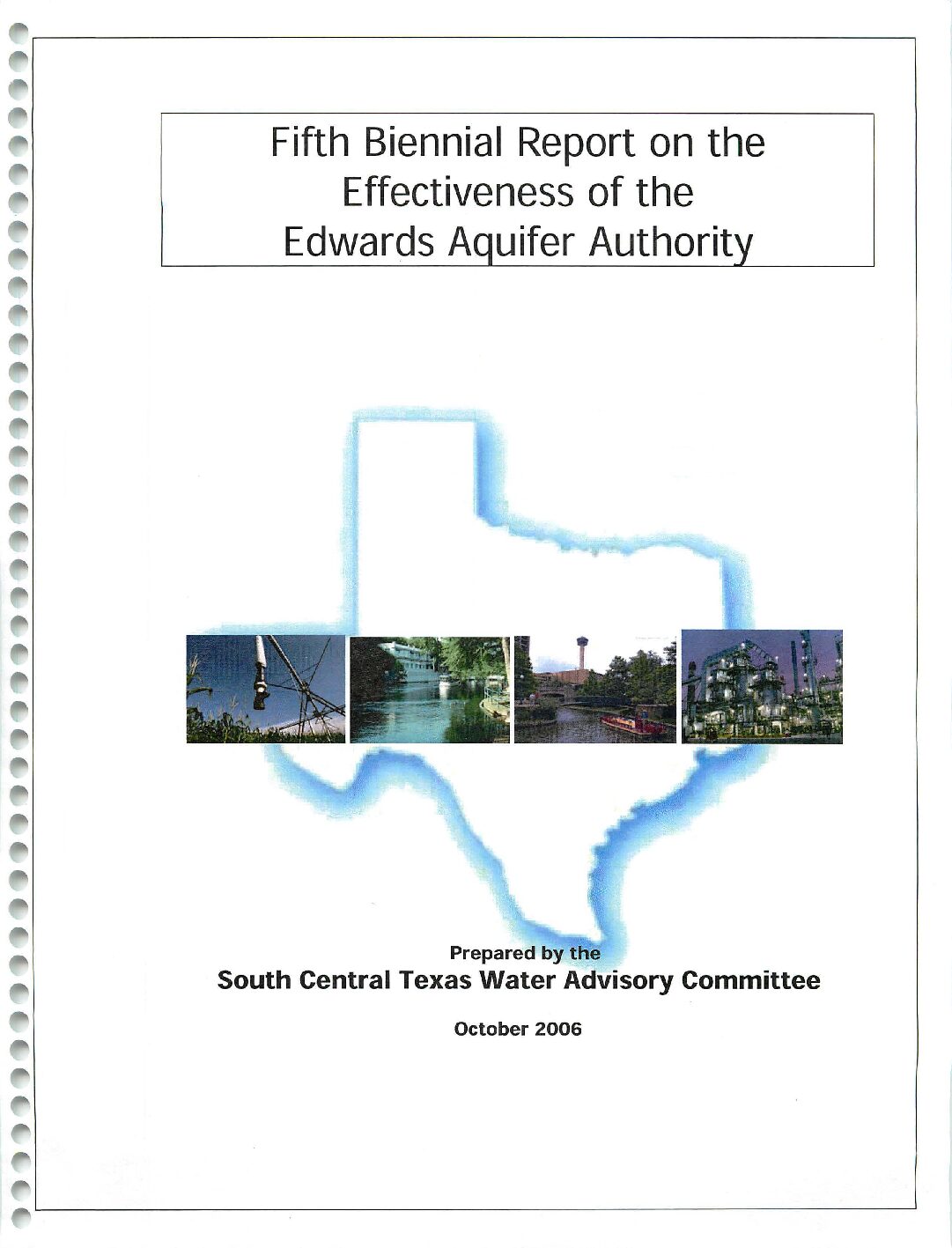
Description: Central Texas Water Advisory Committee for FYs 2004-2006, and recommendations for future actions
Location: Edwards Aquifer Authority jurisdiction
Summary:The South Central Texas Water Advisory Committee submits a report assessing the effectiveness of the Edwards Aquifer Authority (EAA) every two years to the EAA Board of Directors and to the Texas Commission on Environmental Quality. This is the Advisory Committee's report on the effectiveness of the Edwards Aquifer Authority (EAA) during the period from October of 2004 through September of 2006.
During the period of review, the EAA has generally performed well in its planning and research activities. The EAA successfully accomplished a transition in its general manager position, and the EAA Board approved a new, flexible strategic plan.
In its regulatory role managing pumping from the Aquifer, the EAA reached a notable achievement by completing the review and issuance of initial regular permit applications. The EAA continued to deal with significant policy issues related to the annual limit on permitted withdrawals and the guaranteed permit minimums. The EAA Board's decisions on these issues continued to reflect a preference for protection of the interests that rely on pumping from the Aquifer over those that rely on springflow from the Aquifer. The backdrop to these decisions has been an extended period of relatively high Aquifer levels and the absence of low springflows such as in the summers of 1990, 1991 and 1996.
Report on the Effectiveness of the Edwards Aquifer Authority

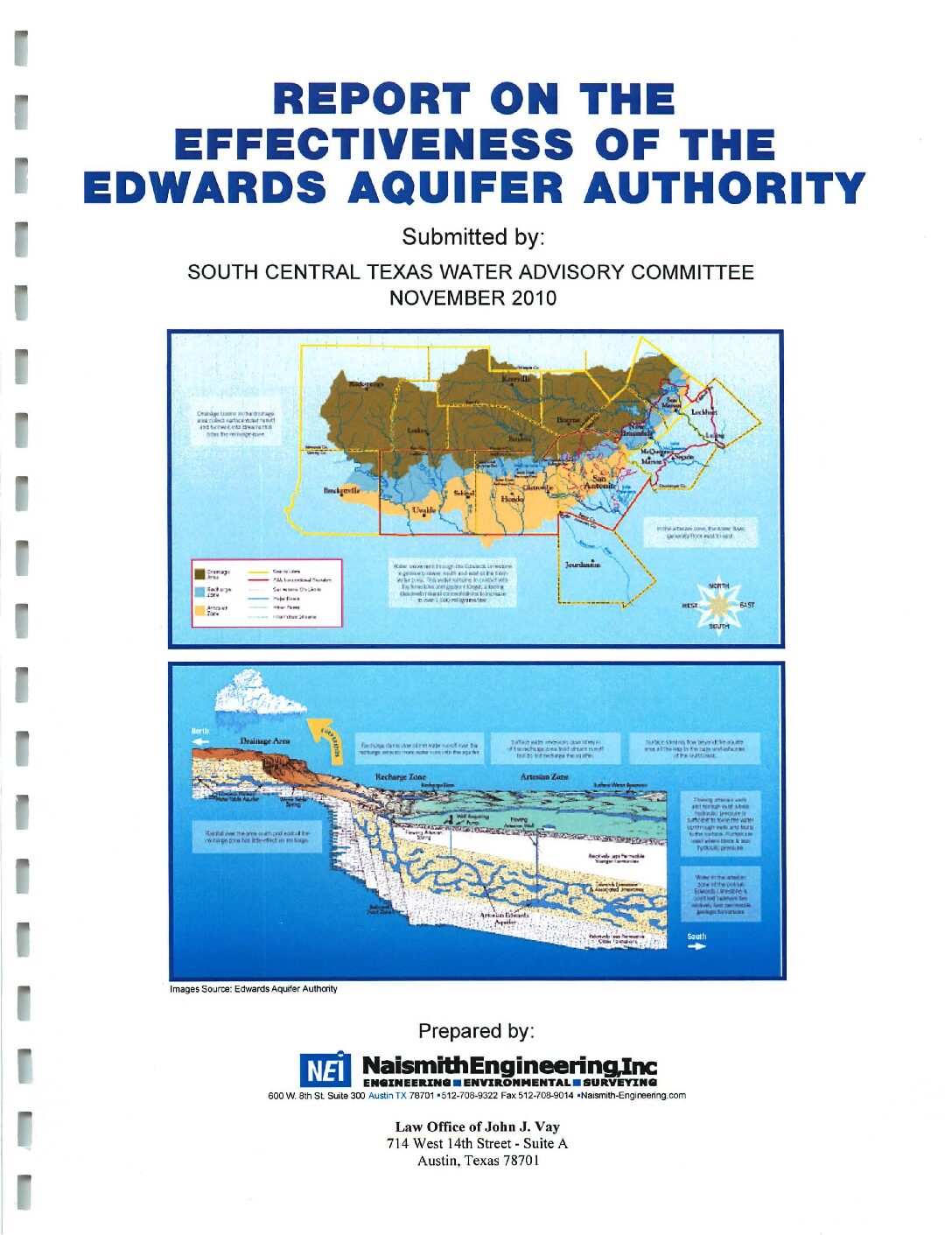
Description: Assessment of the effectiveness of the Edwards Aquifer Authority by the South Central Texas Water Advisory Committee with respect to measures established in 2008
Report Number: X: // 8415/2010 Edwards Aquifer Authority/2010 Effectiveness Report
Location: Edwards Aquifer Authority Jurisdiction
Summary:The South Central Water Advisory Committee (SCTW A C) was established by the Texas Legislature in the Edwards Aquifer Authority (EAA) Act. The SCTW AC represents downstream interests in the Guadalupe, San Antonio and Nueces River Basins and is charged with developing an Effectiveness Report on the Edwards Aquifer Authority every even numbered year and submit the report to the Texas Commission on Environmental Quality (TCEQ). The Effectiveness Report is required to assess:
1. The effectiveness of the EAA.
2. The effect on downstream water rights by the EAA management of the aquifer.
Specific points that are to be considered in this evaluation include:
*Whether the EAA has functioned as an effective organization;
*Whether the EAA has played a significant role in regional planning activities;
*Whether the EAA has complied with statutory mandates and deadlines provided in the EAA act;
*Whether the EAA has provided for effective protection of water quality in the aquifer and in contributing streams;
*Whether the EAA has achieved its water conservation goals; and
*Whether the EAA has provided effective protection of aquatic and wildlife habitat, endangered and threatened species, in-stream uses and bays and estuaries that depend on the aquifer.
The 2010 Effectiveness Report reviewed the effectiveness measures established in the 2008 report and if the EAA had met the standards established by those measures. The effectiveness measures were divided into the following areas:
*Regulatory Effectiveness Measures
*Research Effectiveness Measures
*Financial Effectiveness Measures
*Planning Effectiveness Measures
*Administrative Effectiveness Measures
*Development of a Comprehensive Public Information Plan
In general the SCTW AC concurs that the EAA met or exceeded the effectiveness measures established in the 2008 report.
Robust Representation of Dry Cells in MODFLOW

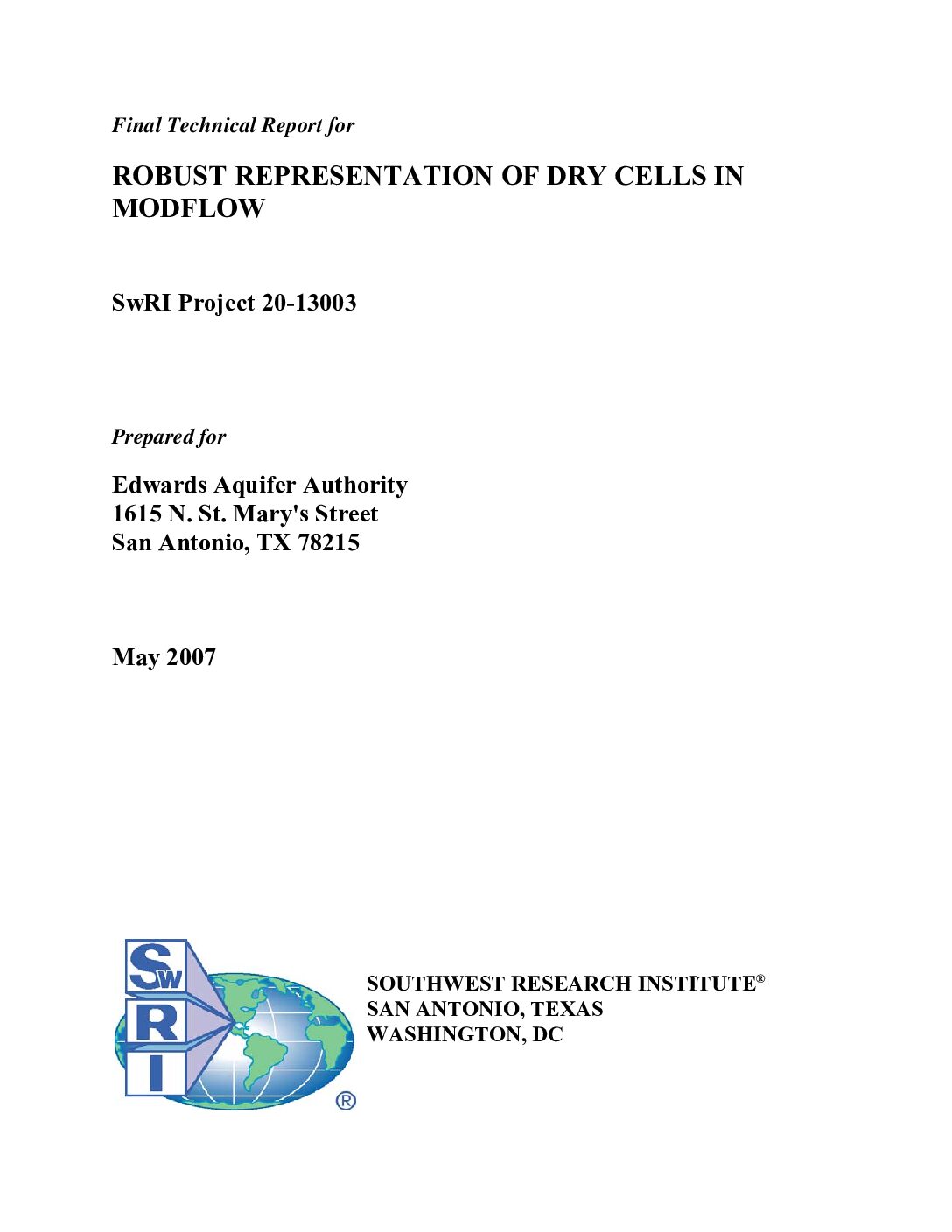
Description: Documentation and testing of MODFLOW-NR to improve method for dealing with dry cells in modeling the Edwards Aquifer
Report Number: 20-13003
Location: Edwards Aquifer, Balcones Fault Zone, San Antonio Segment
Summary:When MODFLOW calculates a water level that is below the base elevation of a computational cell, that cell is declared to be dry and removed (temporarily or permanently) from the calculation, causing the model to produce unreliable results. This problem with the MODFLOW system is well-known and long-standing. The dry-cell issue was a significant obstacle to modeling water management scenarios with the Edwards Aquifer model because cells in the recharge zone often went dry. This report describes a new variant of MODFLOW, denoted MODFLOW-NR, that incorporates a recently developed robust computational scheme for representing dry cells. The new representation of dry cells combines an upstream-weighting algorithm for intercell conductances with a new solver package. This report summarizes the capabilities, technical basis, data input requirements, software validation/verification tests, and example simulations for the MODFLOW-NR software. The study was completed in May 2007 by Southwest research Institute®, San Antonio, Texas.
The combination of upstream weighting of intercell conductances with a Newton-Raphson solver avoids numerical instabilities and artifacts associated with dry cells. Tests performed to date using the MODFLOW-NR code indicate that the approach is very robust. Comparisons with the unmodified MODFLOW-2000 code demonstrate that the upstream weighting and conventional spatial differencing approaches produce very similar results.
Version 1.0 of MODFLOW-NR is limited to single-layer aquifers. However, the approach is applicable to aquifers with multiple layers. Fully three-dimensional capabilities could be added to future versions with a reasonable level of effort.
MODFLOW-NR has been tested with the Well, Drain, Recharge, River and Horizontal Flow Barrier packages. The recently developed Well Pumping Management Package (WMP1) is not included in Version-1 of MODFLOW-NR, but could be incorporated in future versions.
Additional Graphical Materials to the Edwards Aquifer (San Antonio Region) Groundwater Flow Model (Lindren et al., 2004)

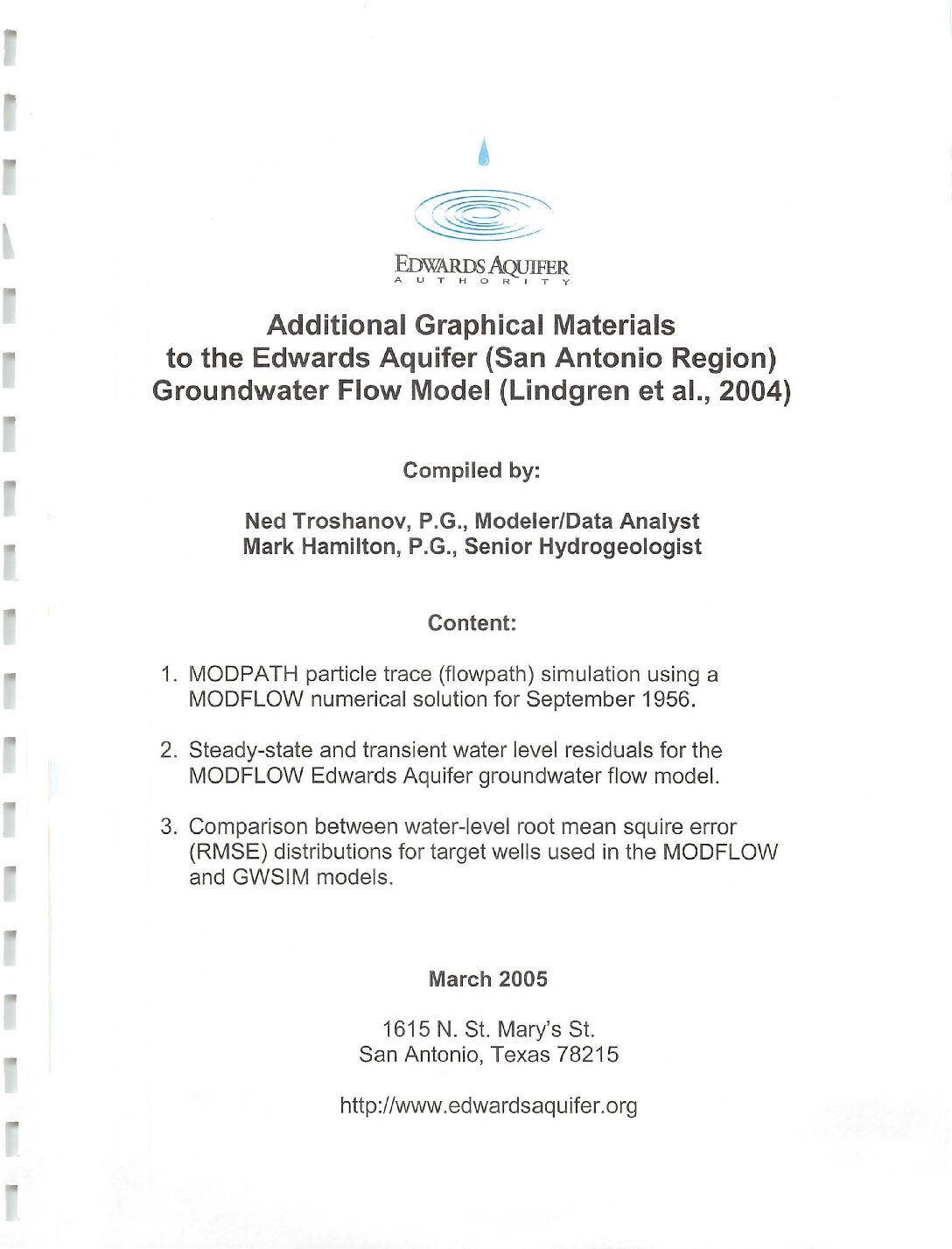
Description: Visual output for flowpath simulation, steady-state and transient water level residuals, and water-level root mean square error distributions for target wells using MODFLOW/GWSIM models and data from Lindgren et al, 2004
Location: Edwards Aquifer, Balcones Fault Zone, San Antonio Segment
Summary:1. MODPATH particle trace (flowpath) simulation using a MODFLOW numerical solution for September 1956.
2. Steady-state and transient water level residuals for the MODFLOW Edwards Aquifer groundwater flow model.
3. Comparison between water-level root mean square error (RMSE) distributions for target wells used in the MODFLOW and GWSIM models.
Edwards Aquifer Authority Aquifer Science Research Program Plan 2012-2015

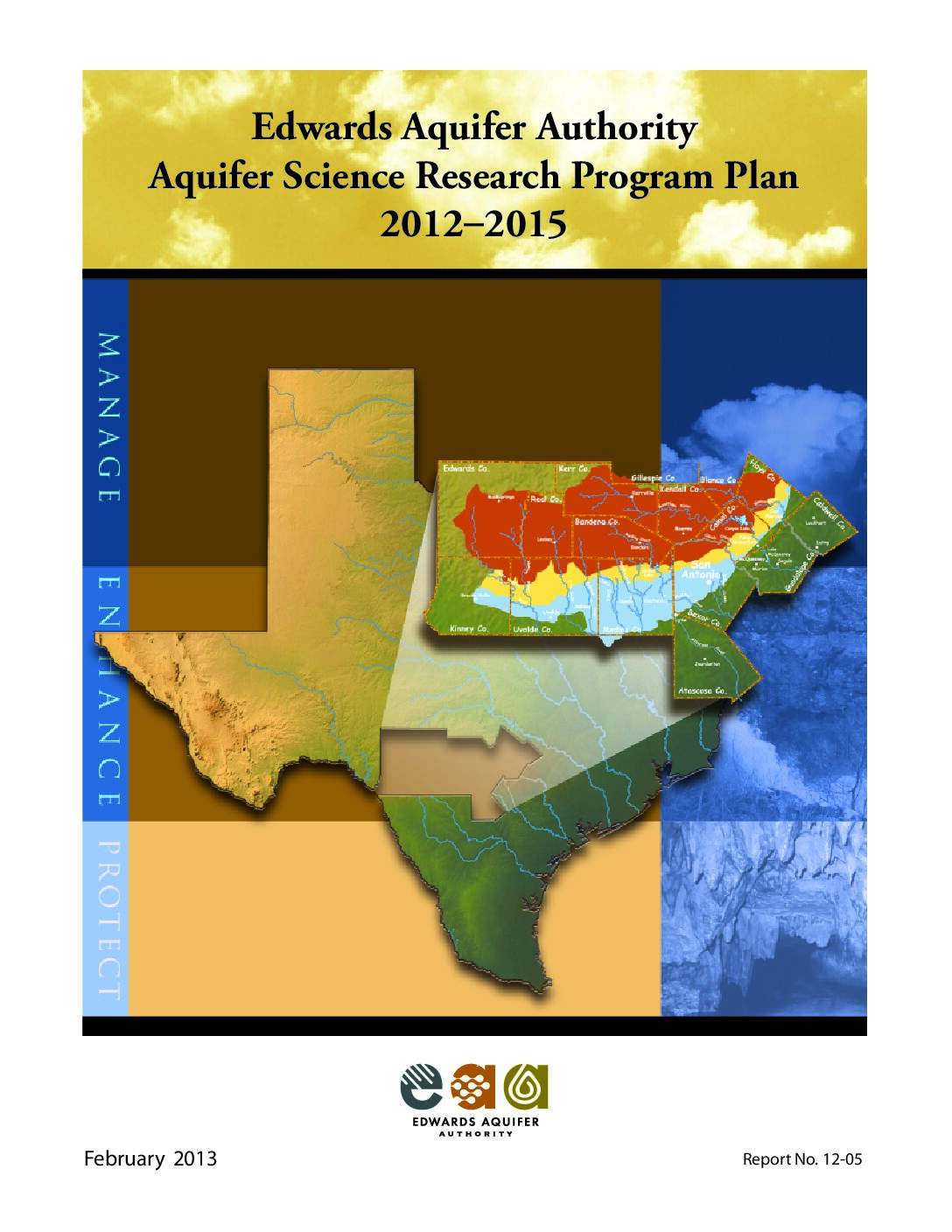
Description: Edwards Aquifer Authority Aquifer Science Research Program Plan for 2012-2015
Report Number: 5-Dec
Location: Edwards Aquifer Authority Jurisdiction
Summary:Purpose of the Aquifer Science Research Program Plan
The purpose of this Aquifer Science Research Program Plan (ASRPP) is to provide a strategic planning document to direct EAA aquifer research. The ASRPP is developed and implemented by the Aquifer Science Program staff to gain a better understanding of the properties of the Edwards Aquifer. The ASRPP is updated every two to three years and relies on input from EAA staff, the Aquifer Science Advisory Panel (ASAP), and the Technical Advisory Group (TAG), with final approval of all projects provided by the EAA Board of Directors. The ASAP is an outside panel of experts with extensive credentials in the groundwater sciences. The TAG is composed of representatives for local and regional private and public entities with an interest in the Edwards Aquifer.
Goals and Objectives of the ASRPP
This document is intended to serve as guidance to the EAA for aquifer research.
The goal of the ASRPP is to outline the research needed to provide the best available technical information to policy decision makers as efficiently as possible. Although a substantial body of knowledge exists regarding the hydrogeology of the Edwards Aquifer, many unknowns remain with respect to the aquifer's properties and characteristics. Continued data collection and research must concentrate on supplementing, refining, and improving aquifer knowledge to provide policy makers with adequate information to make decisions that assist in implementation of the EAA Act.
Using the current knowledge base derived from existing research and data, the EAA is poised to make further advances in groundwater and surface water modeling, flowpath understanding, recharge methodology, water quality vulnerability, and data collection.
Research Initiatives
Since beginning operations in 1996, the EAA has expanded its data collection and research programs to facilitate a growing body of knowledge of the Edwards Aquifer. The growth in expertise of Aquifer Science staff has allowed the EAA to internalize many of its research initiatives to provide cost savings and greater control over research projects. These projects have included tracer testing, water quality sampling, borehole geophysical logging, passive water quality sampling, and groundwater modeling. In addition, the EAA continues to develop partnerships with numerous public agencies and private entities to further the research capacity of the organization.
Research recommendations have been developed through consultation with EAA staff, the EAA Board of Directors, the ASAP, and the TAG. Proposed projects for 2012 through 2015 (Table 1) are intended to address recommendations from completed studies, continue existing studies (i.e., support projects), or provide information aimed at addressing basic research needs (see Appendix A for detailed descriptions of proposed active projects). Table 1 also provides a rough order of magnitude (ROM) cost for each proposed project. ROM costs”estimates in current dollars”represent approximate costs. The project listing is subject to modification annually, depending on budgetary limitations, time constraints, or development of new directives (Table 2). Although calendar year 2012 projects were programmed into the EAA annual budget, EAA staff will continue to seek joint funding opportunities for these and other projects. Studies proposed for initiation in calendar years 2013, 2014, and 2015, but not yet under way, are summarized in Table 1, along with a list of the currently anticipated project needs for calendar years 2013 through 2015. As further research and planning takes place, studies will be added and amended for years beyond 2015 so as to accommodate unknowns or new developments at the EAA, as well as improvements in technology.
Methodology for Calculating Specific-Storage Values in the Edwards (Balcones Fault Zone) Aquifer, Central Texas, Using Seismic Efficiencies

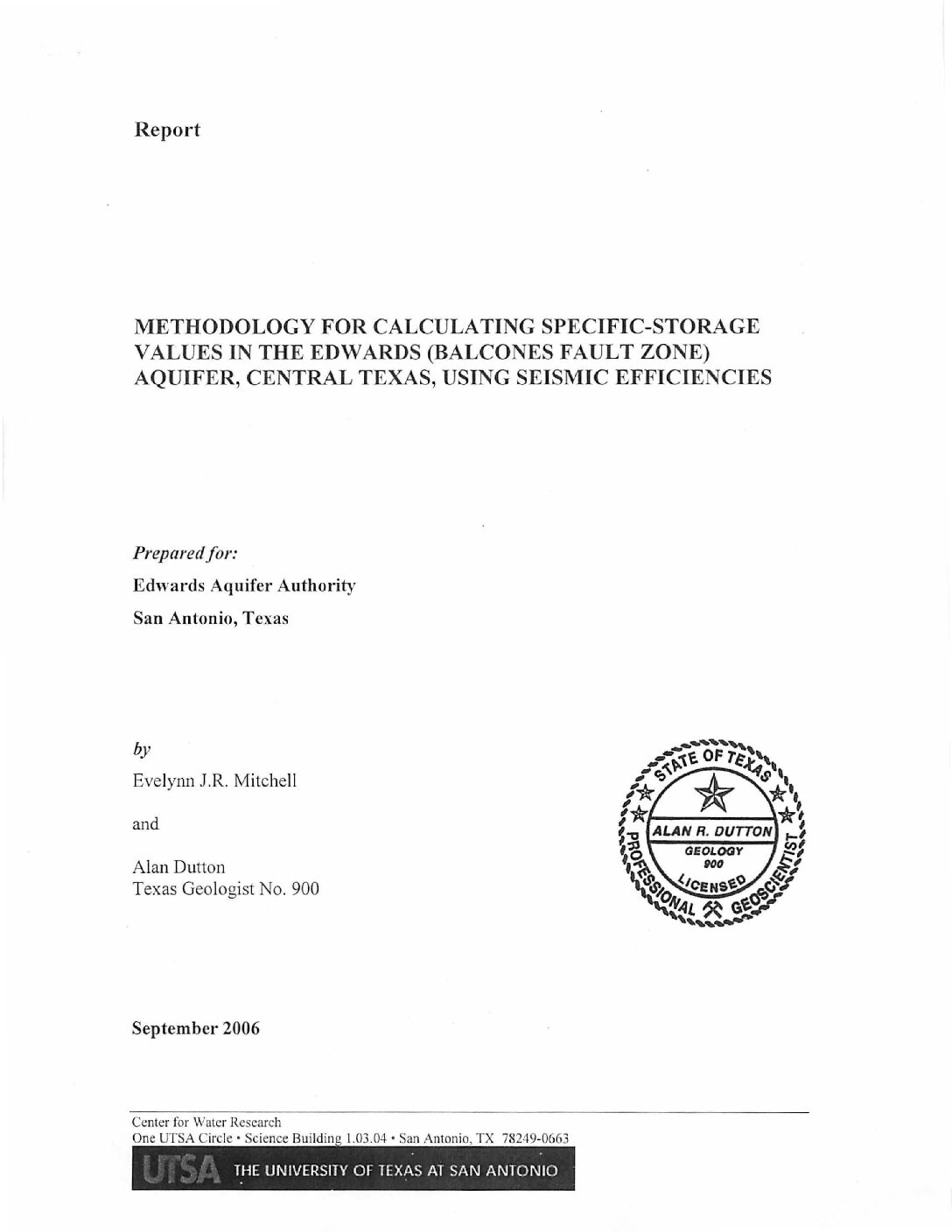
Description: Description of a method to estimate storativity of the Edwards Aquifer, Balcones Fault Zone, San Antonio Segment based on seismic efficiency calculations (transient changes in hydrodynamic pressure after seismic events)
Location: Edwards Aquifer, Balcones Fault Zone, San Antonio Segment
Summary:Specific storage in confined aquifers is usually found from either paired-well field tests or calculated estimates for barometric or tidal efficiency. However, the paired wells required for a drawdown or recovery test are generally sparse in any aquifer, including the Edwards aquifer, so this method does not yield much data. Calculating barometric efficiency requires at least several monthsof detailed records on water levels and atmospheric pressure. Tidal efficiency calculations also require months of water level records as well as access to geodetic data. An additional issue that needs to be addressed is the heterogeneous nature of karst aquifers, where specific storage estimates derived from onewell location maynot represent the aquifer as a whole.
Thus a method is needed that can quantify specific storage regionally, without the problems of the previous methods. Seismic efficiency calculations provide an approach for estimating aquifer compressibility. Pressure waves generated by seismic events can cause a rapid water-level response in confined aquifers asthe surface wave passes. The water-level response lasts <1 hour, so detrending is not needed.
The Edwards aquifer is a logical choice as a study area for this research because seismic events have been shown to produce sizable signals in several of the wells that are equipped with analog or chart recorders. Also, the Edwards aquifer is a known karst aquifer, and therefore a heterogeneous system, with potentially varying storativity.
Groundwater Level Monitoring Plan

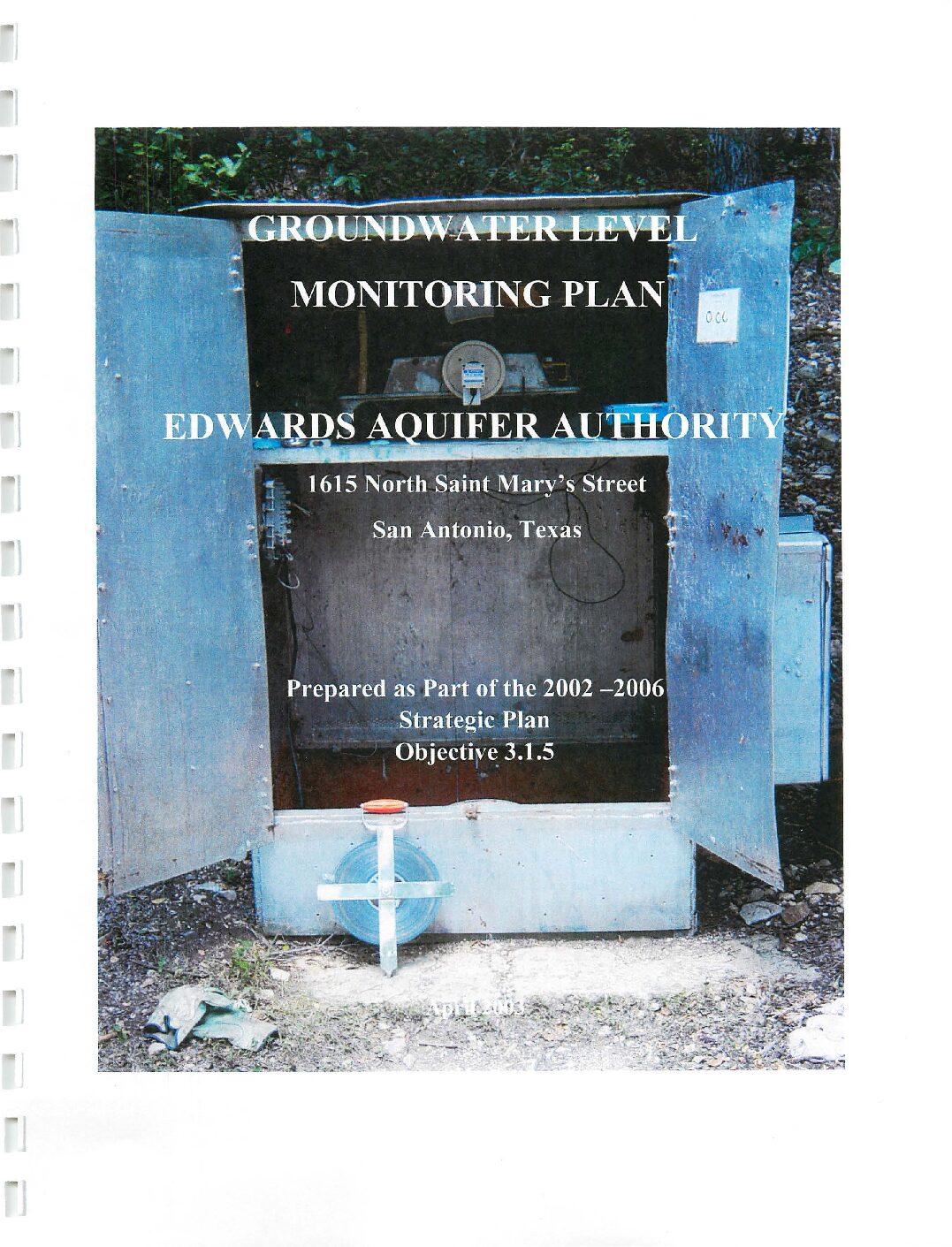
Description: Guidance for collecting groundwater data by the Edwards Aquifer Authority
Location: Edwards Aquifer Authority jurisdiction
Summary:This plan is intended as a guidance document for Authority staff to use when collecting groundwater level data. The importance of this data should not be underestimated, especially when collected properly, and validated in the field. Groundwater level data can be used to better understand aquifer response to stresses related to pumping, and recharge in addition to ascertaining groundwater gradient information, and surface water interactions that occur in the aquifer.
The primary aspects of this document are the use of data quality objectives (DQOs), standard operating procedures (SOPs), and conducting annual reviews of the plan itself to ensure the adequacy of the plan as conditions and data needs change. The use of DQOs will ensure that data collected are consistent, and appropriately flagged when suspect. Incorporation of SOPs into the plan will also contribute to consistent measurements, as well as prevent accidental cross contamination of wells. While the annual review process will help the Authority to maintain an accurate groundwater level data-set, as well as identify and correct anomalous and erroneous data points from future data-sets.
Aquifer Science Research Program Plan: 2006-2011

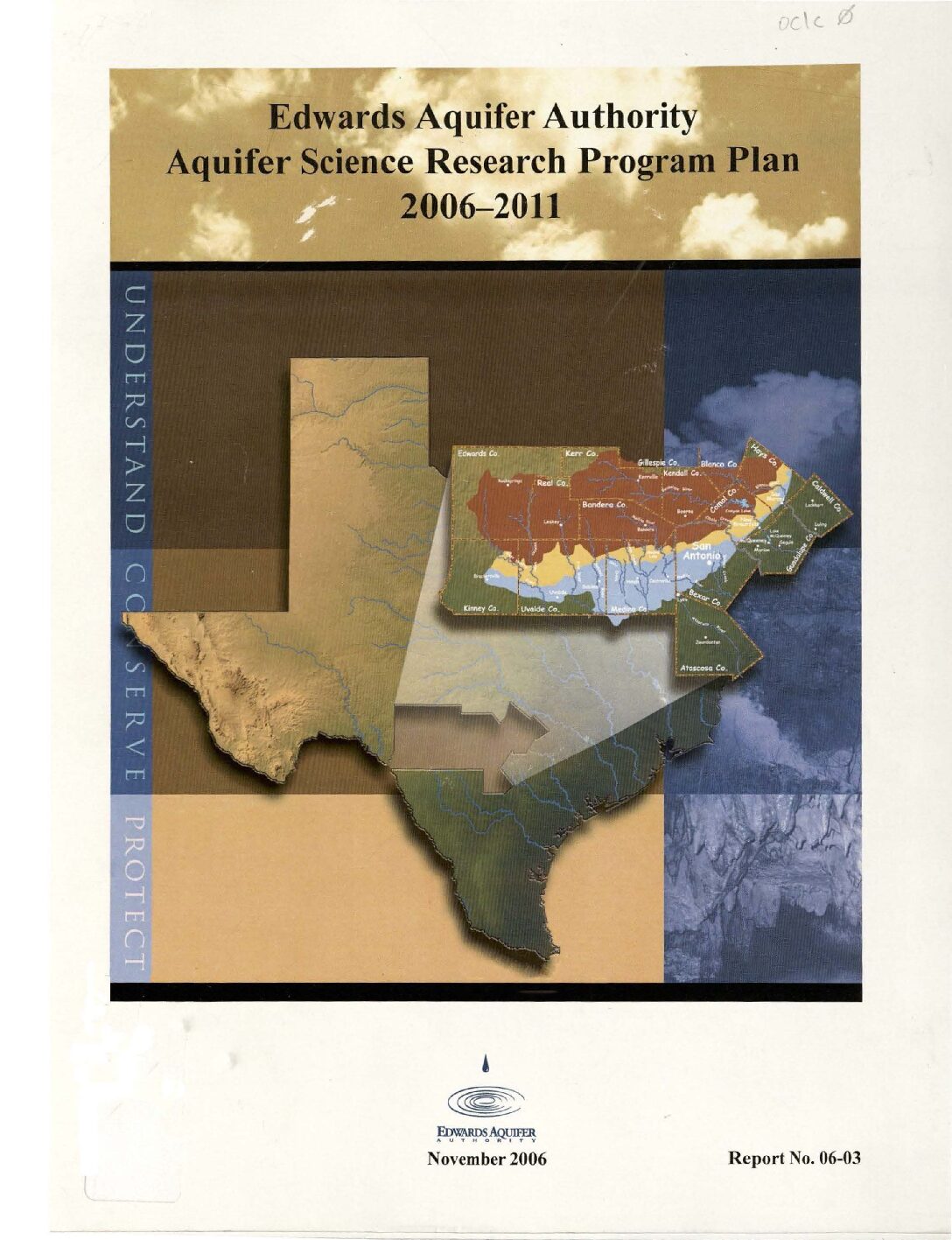
Description: Edwards Aquifer Authority Aquifer Science Research Program Plan for 2006-2011
Report Number: 3-Jun
Location: Edwards Aquifer Authority Jurisdiction
Summary:The Edwards Aquifer is a complex system and to understand the aquifer adequately requires accurate and timely research and data collection . This report summarizes the inception of the Authority s Aquifer Science Research Program (ASRP), which is a natural outgrowth of the Authority's initial research program known as Optimization Technical Studies (OTS). The OTS were performed under the Edwards Aquifer Optimization Program (EAOP), as summarized by Todd Engineers, 1999.
This report will serve as the document for transitioning from the OTS to the ASRP. The ASRP is managed by the Authority, with input from an outside panel of experts referred to as the Aquifer Science Advisory Panel (ASAP), as well as continued input from the Technical Advisory Group (TAG), which helped the Authority develop the original OTS. The ASRP differs from the OTS in that the Authority receives input from the TAG and the new ASAP in relation to research project development and review. The ASRP is also limited to research projects directly related to the Authority's Aquifer Science Program, whereas the OTS included projects outside the Aquifer Science Programs scope. As with the OTS, the board of directors has final approval over all projects prior to initiation.
The document sections provide a discussion of the EAOP, OTS, and the new ASRP in greater detail. In order to document the various projects associated with the ASRP and OTS, summary tables are provided in each respective section, and detailed descriptions are provided in the appendices. Appendix A provides detailed descriptions of proposed ASRP projects. Detailed descriptions and status summaries of active OTS projects (many of which will be absorbed into the ASRP) are provided in Appendix B. Projects completed under the OTS are listed in Appendix C.
Proposed 10-Year Plan for Continuation of Hydrologic Studies of the Edwards Aquifer, San Antonio Area, Texas

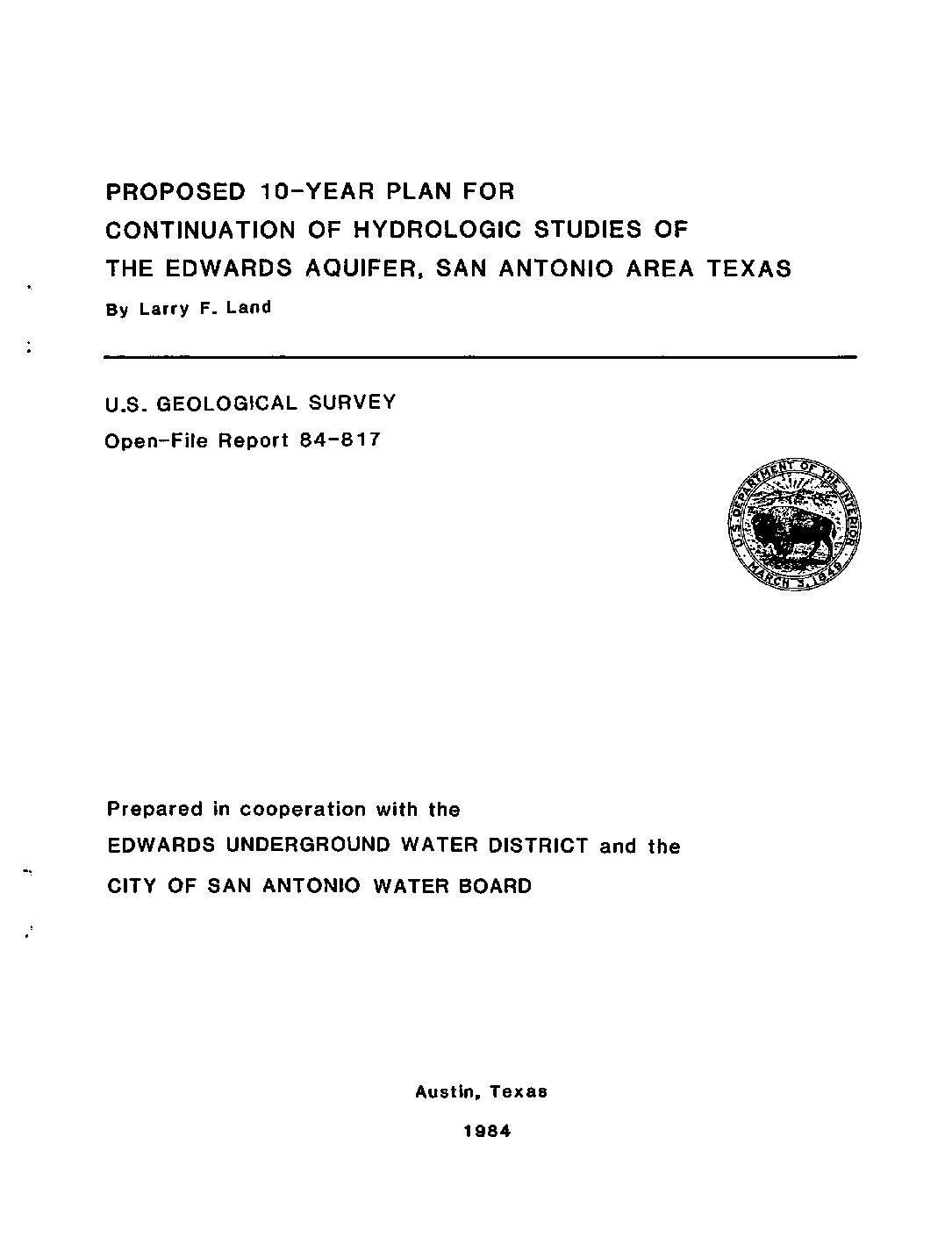
Description: Ten-year research priorities for the Edwards Aquifer Balcones Fault Zone San Antonio Segment conducted jointly by the Edwards Underground Water District and the U.S. Geological Survey
Report Number: USGS O-FR 84-817
Location: Edwards Aquifer Balcones Fault Zone San Antonio Segment
Summary:The importance of the Edwards aquifer as a freshwater resource and its susceptibility to being contaminated, being over utilized, or both resulted in the development of a proposed 10-year plan to monitor and study its hydrology. The plan proposes adjustments to the current monitoring activities of computing and measuring recharge, discharge, withdrawals, water levels, and water quality. To conduct the needed special studies, the plan recognizes the need for the construction and drilling of many new wells at specific locations and to selected depths. Many of the wells wi1 be in clusters so that data can be obtained on a stratigraphic basis.
Some of the topics identified for special study include: (1) The potential of saline water entering the freshwater zone from the downdip boundary; (2) the possibility of water leaking into the aquifer from an overlying aquifer; (3) the effects of urbanization on ground-water qua1ity in loca1 areas; (4) the movement and dissipation of a recharge water plume; (5) the influx of water from the Glen Rose Formation; (6) the effects of the fault barriers, regional dense bed, and irregular geologic framework on ground-water flow patterns; (7) natural recharge-discharge relationships; (8) the aquifer stage-storage relationship; (9) natural water-quality evolution; and (10) a refinement of the hydrogeologic framework in a local area.
Edwards Aquifer Storage Assessment, Kinney County to Hays County, Texas

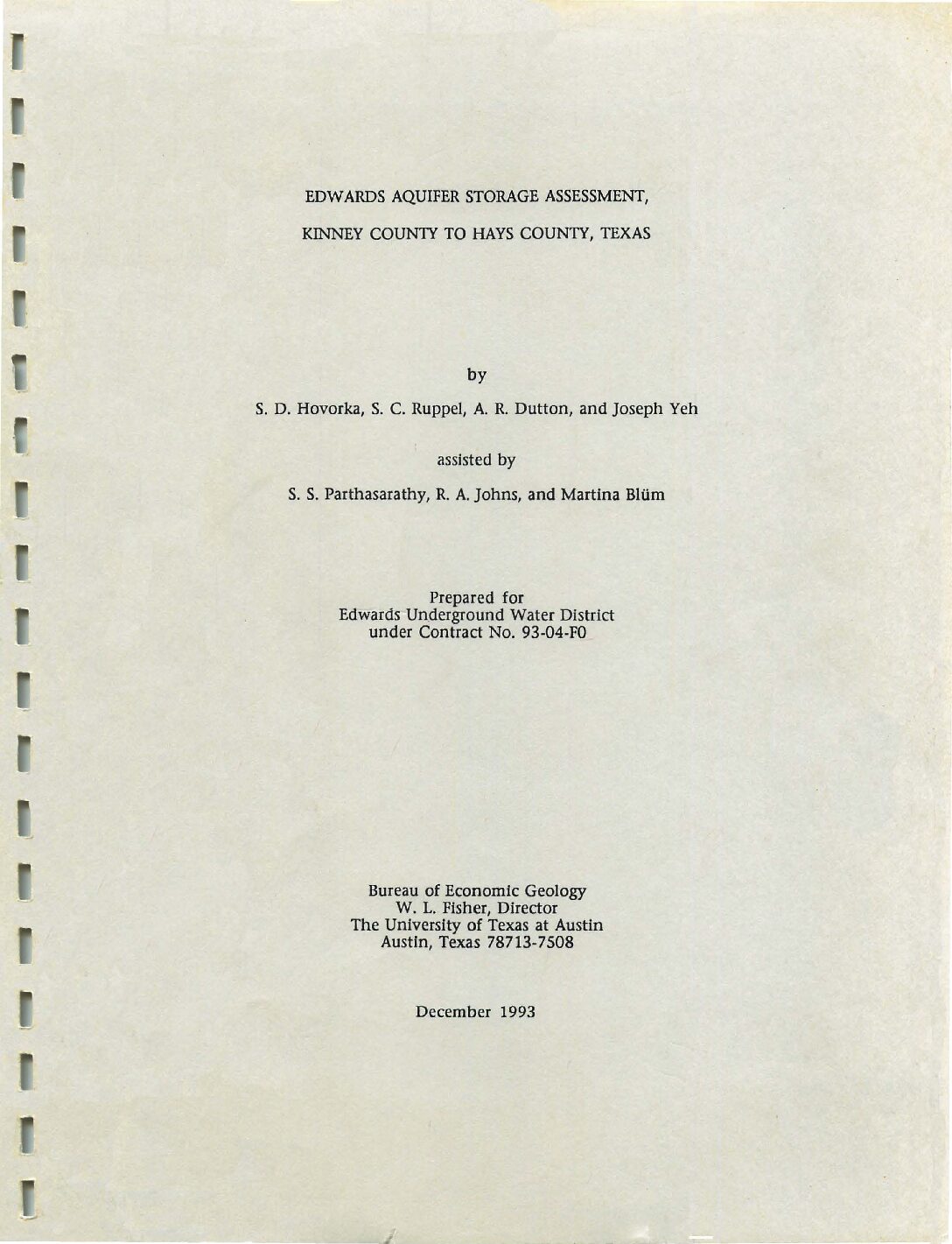
Description: Core- and log-based stratigraphic study of permeability, porosity and storativity in the Edwards Aquifer
Report Number: Contract 93-04-FO
Location: Edwards Aquifer, Balcones Fault Zone, San Antonio Segment
Summary:The distribution of water in the Edwards aquifer was assessed using a core- and log-based stratigraphic study that included 200 neutron and resistivity logs and 300 porosity and permeability plug analyses. The Kainer, Person, Devils River, West Nueces, McKnight, and Salmon Peak Formations of the Edwards Group were investigated during this study. The aquifer extends over 3,111 mi2 (8,004 km2) and thickens toward the south from approximately 500 to 780ft (150 to 240 m). In the Edwards outcrop, the aquifer thins northward because of erosion and decreased saturated thickness. Porosity data were interpolated between wells to create a three-dimensional cell-based model of porosity.
Porosity distribution reflects both the depositional rock fabric and later diagenesis. Small-scale vertical variations in porosity are the result of facies changes caused by high-frequency cyclidty In the depositional environment. Vertical facies stacking influences the amount of dolomitization and diagenetic enhancement of porosity. Subtidal fades deposited during major sea-level highstands are generally undolomltized and exhibit low porosity (4- to 12-percent porosity). Grainstones at cycle tops in the Kainer, Person, and Devils River Formations are typically high-porosity intervals with high depositional porosity that may have additional solution enlargement of pores and pore throats (20- to 42-percent porosity). Dolomltized subtidal facies have very high porosity in intervals with stacked tidal-flat cycles because of preferential dolomite dissolution.
The average porosity of the Edwards aquifer in the study area is 21.7 percent. Variation in average porosity reflects depositional environment and possibly structural and hydrologic Influence on secondary porosity development and cementation. Low porosity is characteristic of the West Nueces and McKnight Formations of the Maverick Basin. The overlying Salmon Peak Formation has moderate to high porosity. In the Devils River, Kainer, and Person Formations, local high and low porosity Is encountered In structurally complex areas that may be related to variable ground-water flow rates and chemistry and consequent variations In pore enlargement or cementation. A high-porosity area is found in southern Medina and southwestern Bexar Counties on both sides of the saline-freshwater interface known as the bad water line.
The total water-filled pore volume of the Edwards aquifer within the study area is 215 million acre-feet. The volume in the unconfined part of the aquifer, above the 1984 potentiometric surface, which is among the lowest ever recorded, Is 6.9 million acre-feet.
Storativity of the confined part or the aquifer was estimated using barometric efficiency and net porosity. Barometric efficiency was calculated by comparing water-level hydrographs in nine observation wells with atmospheric pressure changes. The storativity calculated using this method averages 2.6 x 1Q-4. This approach has the potential for quantifying variations in storativity throughout the confined Edwards aquifer but must be verified by comparison with results of aquifer tests. Such data will improve prediction of how water levels will respond to withdrawal of water from the aquifer.
Edwards Aquifer Authority Technical Documents Project Phase II

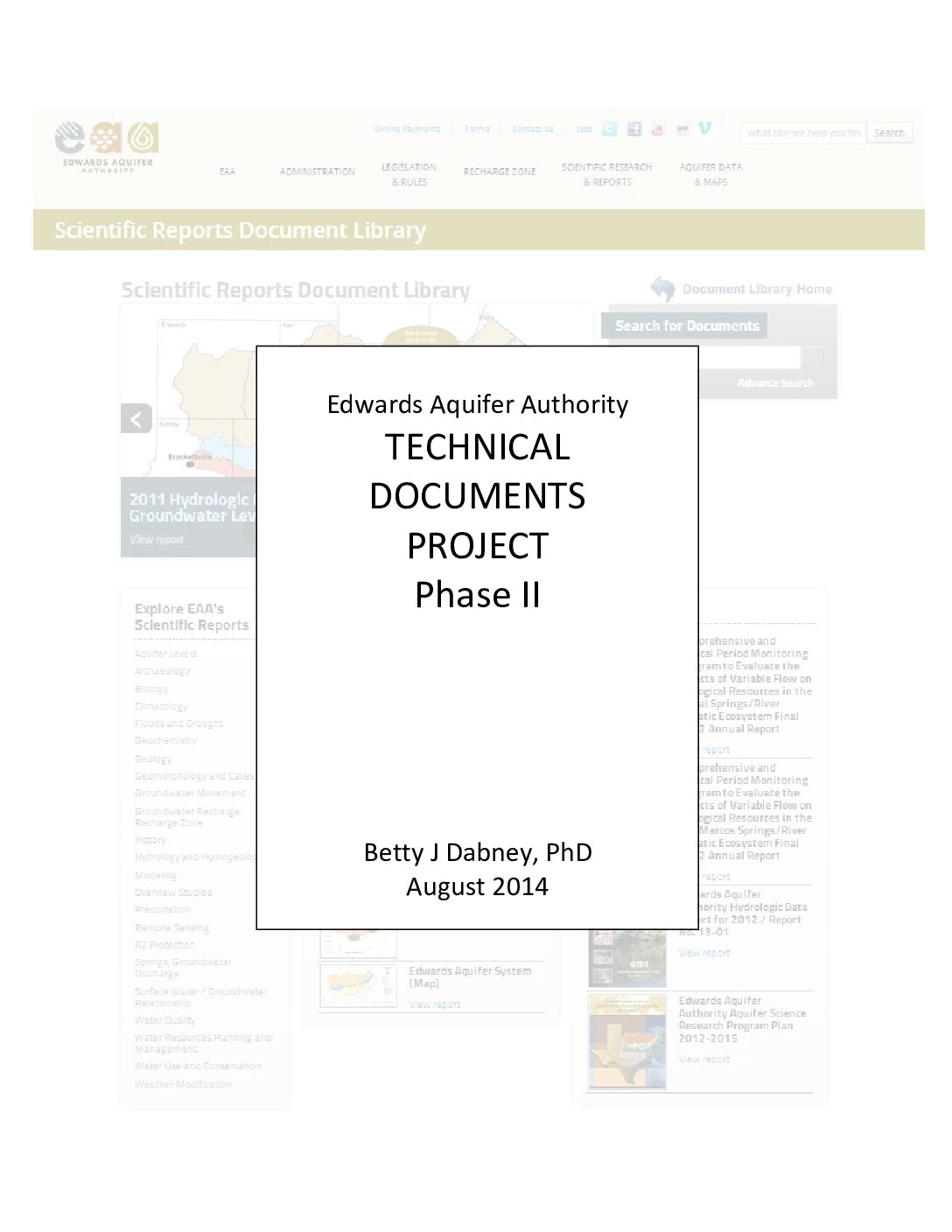
Description: Documentation of Phase II of the Edwards Aquifer Authority Technical Documents Project from 2012-2014
Location: Edwards Aquifer Authority Jurisdiction
Summary:This is the continuation and completion of the Edwards Aquifer Authority (EAA) Technical Documents Project, which began in 2012 and was documented in the Phase I Report (Dabney, 2012). In addition to discovering, digitizing, indexing and uploading the remaining EAA Technical Documents, Phase II also included two other projects:
- Performing a similar process for the documents comprising the record of the EAA Recovery Implementation Plan and Environmental Impact Statement which led to the adoption of the Habitat Conservation Plan by the U.S. Department of the Interior Fish and Wildlife Service (http://eahcp.org/), and also:
- A detailed Quality Control assessment of the EAA on-line Scientific Reports Documents Library on the new EAA website (https://www.edwardsaquifer.org/scientific-research-and-reports/scientific-reports-document-library).
Edwards Aquifer Authority Aquifer Science Research Program Plan 2008-2013

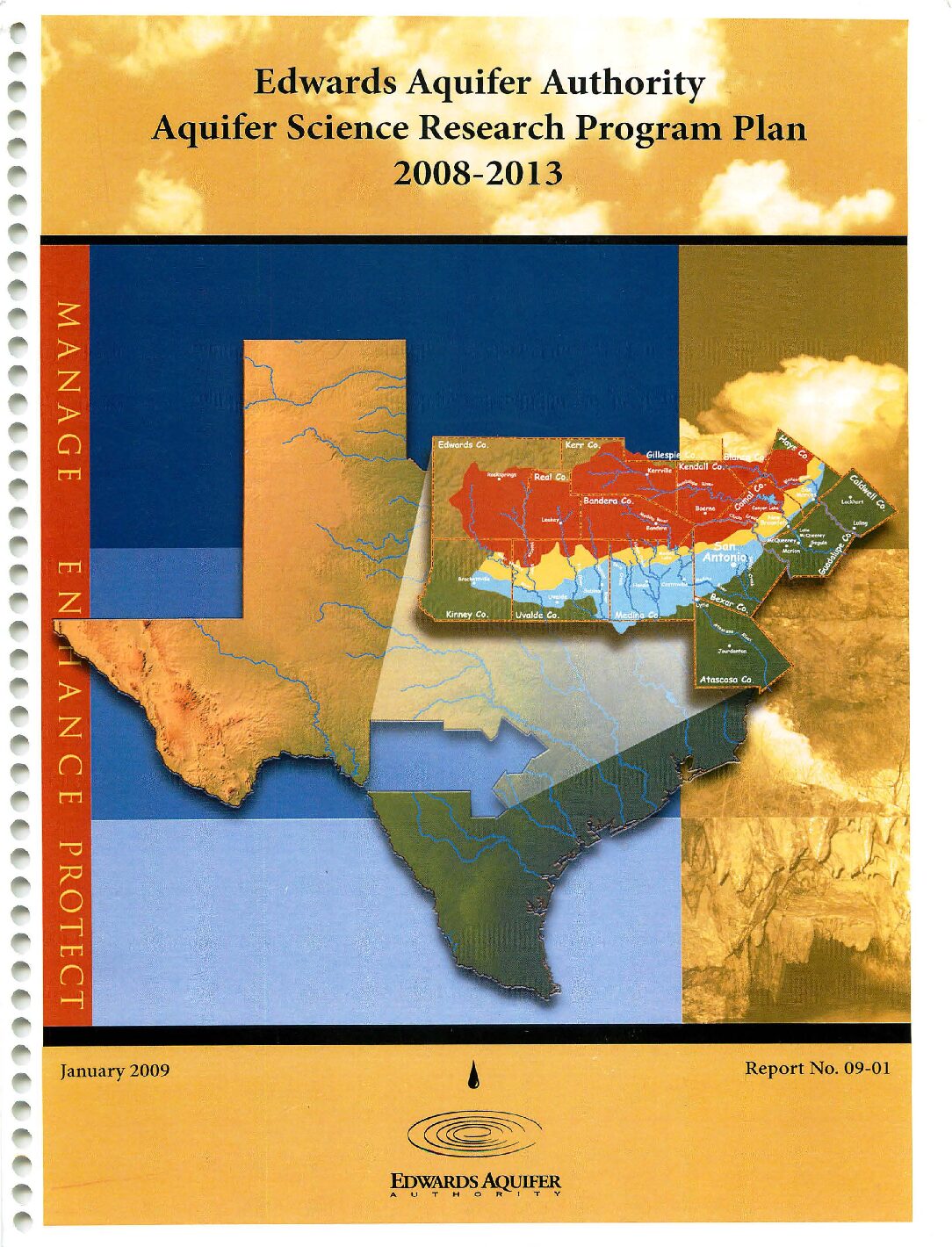
Description: Edwards Aquifer Authority Aquifer Science Research Program Plan for 2008-2013
Report Number: 1-Sep
Location: Edwards Aquifer Authority Jurisdiction
Summary:The Edwards Aquifer is a complex system, and to understand the aquifer adequately requires accurate and timely research and data collection. This report summarizes the inception of the Authority's Aquifer Science Research Program {ASRP), which is a natural outgrowth of the Authority's former research program known as Optimization Technical Studies (OTS). The OTS were performed under the Edwards Aquifer Optimization Program (EAOP) as summarized by Todd Engineers, 1999.
The ASRP is managed by the Authority with input from an outside panel of experts referred to as the Aquifer Science Advisory Panel (ASAP), as well as continued input from the Technical Advisory Group (TAG), which helped the Authority develop the
original OTS. The ASRP differs from the OTS in that the Authority received input from the TAG and the ASAP in relation to research project development and review. The ASRP is also limited to research projects related directly to the Authority's Aquifer Science Program, whereas the OTS included projects outside the scope of the Aquifer Science Program. The Authority's board of directors has final approval over all projects prior to initiation.
The Edwards Aquifer Authority Aquifer Science Research Program Plan 2006-2011 {ASRPP-2006), which was released in November 2006, documents the Authority's transition from the OTS to the ASRP. The Aquifer Science Research Program Plan 2008-2013 (ASRPP-2008), the first update and revision to the ASRPP-2006, contains information on the status of existing research programs, as well as new research initiatives.
In order for the various projects associated with the ASRP to be documented, summary tables are provided in each section, whereas detailed descriptions are provided in the appendices. Appendix A provides detailed descriptions of proposed and active ASRP projects (some of which began as OTS projects), and completed projects (ASRP and OTS) are summarized in Appendix B.
Edwards Underground Water District: Created to Conserve, Protect and Preserve the Edwards Aquifer

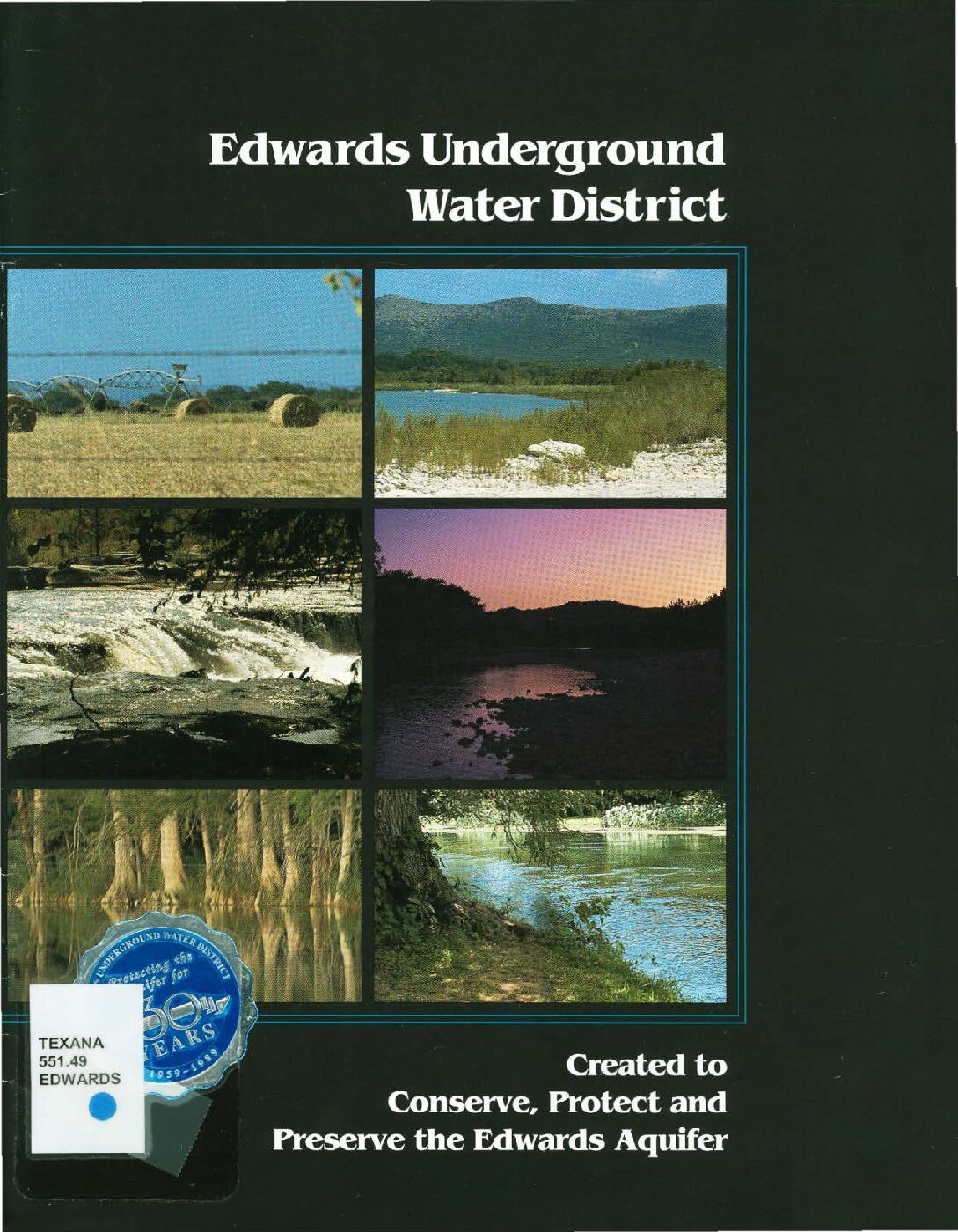
Description: History and overview of the Edwards Aquifer and the Edwards Underground Water District
Location: EUWD Jurisdiction
Summary:Ground water is one of Texas' most valuable resources. About 70% of the water currently used in Texas is ground water. Recognizing the significance of this resource, the state took steps to provide for the protection of ground water through the enactment of the Underground Water Conservation Districts Act in 1949. The Act provided for the creation of underground water districts as a means of local self-government and management of water resources.
The state also enacted legislation establishing special law districts for the protection and conservation of ground water resources in particular regions. One such special law is the enabling statute of the Edwards Underground Water District (EUWD).
The Edwards Underground Water District was created in 1959 to conserve, protect and preserve the Edwards Aquifer.
One of the most productive aquifers in the southwestern United States, it currently supplies high-quality water to over one million people for municipal, industrial, agricultural and recreational purposes. Since its creation, the EUWD has been fulfilling its responsibilities by undertaking programs for monitoring water quality, enhancing aquifer recharge and encouraging conservation. The District has also led efforts to plan for water resources of the aquifer region.

 Aquifer Conditions
Aquifer Conditions
 CURRENT
CURRENT 
